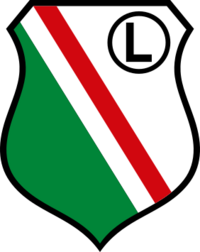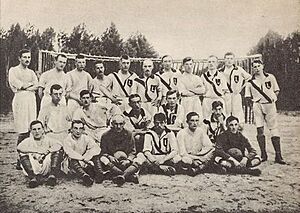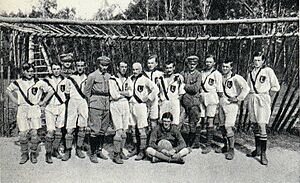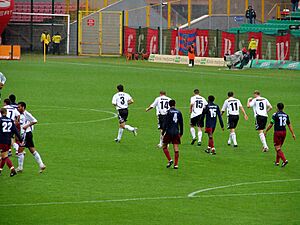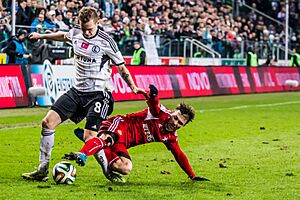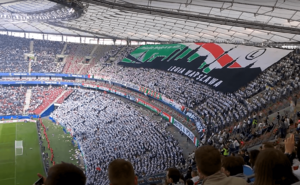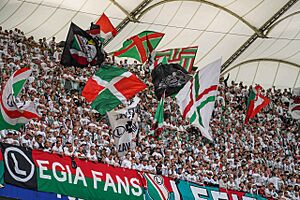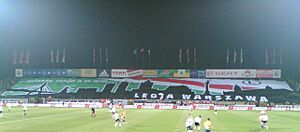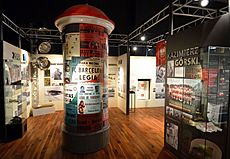Legia Warsaw facts for kids
Legia Warsaw is a professional football club from Warsaw, Poland. It is often called simply Legia. Legia is the most successful Polish football club ever. They have won a record 15 Polish championship titles (called Ekstraklasa), a record 21 Polish Cup trophies, and 6 Polish Super Cup trophies. Their home stadium is the Polish Army Stadium. Legia is the only Polish club that has never been moved down from the top league since World War II.
Legia was started between March 5 and 15, 1916, during World War I. It was the main football club for the Polish Legions. After the war, the club was restarted on March 14, 1920, in Warsaw. It became the official football club of the Polish Army. From 1949 to 1957, Legia was known as CWKS Warszawa.
The club was owned by different groups over the years. Since January 9, 2014, it has been owned by Dariusz Mioduski, who is also the club's chairman.
Contents
- Club History
- How Legia Started
- The 1920s and 1930s
- The 1940s: After World War II
- The 1950s: First Trophies
- The 1960s: Strong Performances
- The 1970s: Golden Age of Polish Football
- The 1980s: More Cup Wins
- The 1990s: League Titles and European Runs
- The 2000s: New Ownership and More Titles
- The 2010s: Champions League Return
- 2021–Present: Continued Success
- Stadium and Training Facilities
- Sponsors
- Club Identity and Supporters
- Relations with Other Clubs
- Club Achievements
- Legia Warsaw in International Football
- Club Records
- Club Seasons
- Players
- Images for kids
- See also
Club History
How Legia Started
Legia was formed between March 5 and 15, 1916, during World War I. This happened in a village called Kostiuchnówka. The club was for the Polish Legions, who were fighting at the time. Many Polish soldiers were young men who played football before the war. Playing football was a good way for them to spend their free time during quiet moments at the front.
The first team training started in 1915. In March 1916, a sergeant named Zygmunt Wasserab asked to create a football club. The name "Sporting Team Legia" was chosen. The team's colors were white and black. They had a white letter "L" on a black background as their symbol.
In the spring of 1916, Legia played many matches and won most of them. The team moved to Warsaw in July 1916. Their first match in Warsaw was on April 29, 1917, against Polonia Warsaw. It ended in a 1–1 draw. Legia also won an away game against KS Cracovia, who were the Polish champions then. This made Legia an unofficial champion of the country.
The 1920s and 1930s
The club was restarted on March 14, 1920. A group of former officers formed the Military Sports Club (WKS) Warsaw. They chose white and red as the club colors. In 1922, the club's name was changed to Military Sports Club "Legia" Warsaw. They also joined with another club called Korona. This brought new white and green club colors.
Legia played its first international match on May 18, 1922. They lost to a Czechoslovakian club. In 1927, Legia joined the new Polish Football League. Their first league game was on May 8, where they won 6–1. Legia player Marian Łańko scored the club's first league goal and first hat-trick in that game.
In 1930, the Polish Army Stadium was opened. Legia drew 1–1 with Barcelona in the first match there. Legia had its best pre-war results in 1930 and 1931, finishing close to winning the championship. In 1936, Legia lost seven games in a row and was moved down from the top league for the only time in its history. The club decided to focus on friendly matches for a while.
The 1940s: After World War II
After World War II ended in April 1945, the club was restarted. It was first called the 1st Military Sports Club Warsaw. In June, the name Legia was added back. The team played friendly matches with local teams and clubs from other countries.
In 1948, Legia returned to the top league after a nine-year break. They finished fourth in the league. For the next two seasons, Legia stayed in the top division. In November 1949, the club changed its name again to Central Military Sports Club. The Polish People's Army became the official supporter of the team. This allowed Legia to get talented players from other clubs.
The 1950s: First Trophies
In 1951, Legia finished third in the league. In 1952, they reached the final of the Polish Cup for the first time, but lost.
Legia won its first trophy on September 29, 1955, by beating Lechia Gdańsk 5–0 in the Polish Cup final. A month later, on November 20, the club won its first Polish championship. This meant Legia won both the league and the cup in the same year, which is called a "doublet." They were the first Polish team to do this.
In 1956, Legia won the doublet again! They won the Polish championship and then beat Górnik Zabrze 3–0 in the cup final. These wins happened because the team was strengthened with players from other clubs who joined the army. Legia also had its biggest win ever, beating Wisła Kraków 12–0.
In 1956, Legia also played in European competitions for the first time. They played in the European Champions Cup but were eliminated. On July 2, 1957, the club officially changed its name back to Military Sports Club "Legia" Warsaw. They also chose the white-red-green-black colors and the current club badge.
Legia players were invited to Spain to play the first match at FC Barcelona's new stadium, Camp Nou, on September 24, 1957. Barcelona won 4–2.
The 1960s: Strong Performances
In the 1960s, Legia was always one of the top teams in the league. In 1960, new lights were installed at the Polish Army Stadium. This meant matches could be played after dark. Legia also scored its 1000th league goal in 1960. They finished second in the league that year.
In the 1963–64 season, Legia reached the Polish Cup final and won 2–1 against Polonia Bytom. This win allowed them to play in the UEFA Cup Winners' Cup. Legia became the first Polish team to reach the quarterfinals of a European club competition.
In 1966, Legia celebrated its 50th anniversary. They won the Polish Cup again, beating Górnik Zabrze 2–1 in the final. This win allowed them to play in the Cup Winners' Cup again. That season, Kazimierz Deyna, a famous player, joined the Legia team.
In the 1968–69 season, Legia won its third Polish championship. They also reached the Polish Cup final but lost. The club also played in the Inter-Cities Fairs Cup for the first time. In 1969, Legia's junior team won their first championship.
The 1970s: Golden Age of Polish Football
The 1970s were a great time for Polish football. In 1971, Legia finished second in Poland. They also reached the quarterfinals of the European Club Champions Cup. From December 1971 to February 1972, Legia went on a tour to Spain and South America. This was the first time the team had visited that part of the world.
In the 1971–72 season, Legia finished third in the league and lost in the Polish Cup final. In September 1972, Legia beat Víkingur Reykjavík 9–0 in a European Cup Winners' Cup match. This is the biggest win for a Polish team in European competition. They later played against A.C. Milan and were eliminated after a close game. In 1973, Legia won its fifth Polish Cup after a penalty shootout.
In early 1974, the club traveled to Spain and France. In January 1975, Legia flew to Australia, becoming the first Polish team to visit all continents except Antarctica. After this season, Robert Gadocha became one of the first Polish players to be transferred to a Western club.
In the autumn of 1976, the club celebrated its 60th anniversary. Legia also played in the Intertoto Cup again. In the late 1970s, Legia did not finish in the top 3 league positions. The 1978–79 season was the last for Kazimierz Deyna at the club. Legia played its 1000th game in the top league that season. On September 18, 1979, a farewell match for Kazimierz Deyna was played against Manchester City.
The 1980s: More Cup Wins
Legia started the 1980s by winning the Polish Cup on May 9, 1980, beating Lech Poznań 5–0. They finished third in the league. A year later, the club won the Polish Cup again. In the 1981–82 season, Legia reached the quarter-finals of the European Club Champions Cup.
In the 1984–85 season, Legia finished second in Poland, which meant they would play in the UEFA Cup. They also reached the quarter-finals of the Polish Cup. The next season, 1985–86, Legia finished second in the league again. They played against Inter Milan twice in the UEFA Cup but were eliminated both times.
At the end of 1987, the speedway track at the Legia stadium was removed, and the football field was made wider. In 1988, Legia reached the Polish Cup final but lost in a penalty shootout. A year later, in 1989, the Warsaw team won the Polish Cup, beating Jagiellonia Białystok 5–2. Two weeks later, they won the Polish Super Cup for the first time.
On September 1, 1989, the long-time player and captain, Kazimierz Deyna, passed away in a car accident. Later that month, Legia played against FC Barcelona in the UEFA Cup Winners' Cup. The first match in Barcelona was a 1–1 draw. Legia lost the return match 0–1 in Warsaw.
The 1990s: League Titles and European Runs
The early 1990s were tough for Legia in the league. In the 1991–92 season, they were close to being moved down to the second league. However, they won their last games and stayed up. The club did better in the Polish Cup. In 1990, Legia won its ninth Polish Cup. A year later, they reached the final again but lost.
In the 1990–91 UEFA Cup Winners' Cup, Legia reached the semi-finals. They beat strong teams like Sampdoria and Aberdeen. They lost to Manchester United in the semi-finals.
In autumn 1992, Legia got its first private sponsor. In 1993, Legia won the Polish championship. However, the next day, the Polish Football Association (PZPN) decided to take the title away from Legia. They gave it to Lech Poznań instead. This was due to claims of unfair play in the last league match. Legia was also banned from European competitions.
In the 1993–94 season, Legia won its fifth Polish title. They also won the Polish Cup and the Super Cup. This was the first time a Polish club won all three trophies in one season! Legia then played in the Champions League qualifiers but lost.
In 1995, Legia won its sixth Polish championship and the Polish Cup again. After winning the championship, Legia qualified for the Champions League group stage. They played against teams like Rosenborg BK, Spartak Moscow, and Blackburn Rovers. Legia finished second in their group and reached the quarterfinals. They lost to Panathinaikos Athens. In the 1995–96 season, Legia finished second in the league.
In 1997, the club changed its structure and got a new sponsor, Daewoo. Legia finished second in the league that year. They also won the Polish Cup and the Super Cup. The new name, "Legia-Daewoo," was not popular with fans.
The 1997–98 season was Legia's last time in the UEFA Cup Winners' Cup. They were eliminated by an Italian team. In the league, they finished fifth. The 1998–99 season ended with a bronze medal in the league.
On August 12, 1999, Legia played its 100th match in European competitions. In the 1999–2000 season, Legia finished fourth in the league. They reached the League Cup final but lost to Polonia Warsaw.
The 2000s: New Ownership and More Titles
In March 2001, Daewoo stopped funding the club. The sponsor's name was removed from the club's name. In the 2000–01 season, Legia finished third in the Polish league. They also played in the UEFA Cup qualifiers.
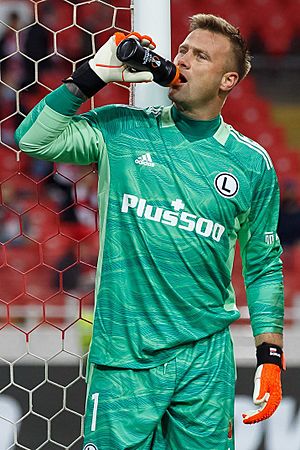
The 2001–02 season was a big success. Legia won its seventh championship title and also triumphed in the Polish League Cup. They played in the Champions League qualifiers but lost to FC Barcelona. After that, they competed in the UEFA Cup.
On June 13, 2003, the club's name changed to KP "Legia" Warszawa SSA. On April 8, 2004, the ITI Group bought the club. The team finished second in the league and reached the Polish Cup final, but lost. The next season, 2004–05, Legia finished third in the league.
The 2005–06 season was special because Legia celebrated its 90th anniversary. They won their eighth Polish championship. The city of Warsaw decided to help pay for a big renovation of the Legia stadium. Legia tried to qualify for the Champions League group stage again but lost to Shakhtar Donetsk. They then played in the UEFA Cup but were eliminated.
In the 2006–07 season, Legia finished third in the league. In 2007, the club changed its badge. The new design was not popular with fans, so they went back to a modified version of the old one.
At the start of the 2007–08 season, there were problems with Legia fans during a match in Vilnius, Lithuania. As a result, UEFA banned Legia from European competitions for five years. However, after an appeal, the ban was reduced. Legia finished second in the league and won the Polish Cup and Polish Super Cup that season. They also reached the Ekstraklasa Cup final but lost. The club joined a campaign called "Let's Kick Racism from the Stadium."
In the 2008–09 season, Legia played in the UEFA Cup qualifiers but were eliminated by a Russian team. They finished second in the league again.
The 2010s: Champions League Return
Legia won its 10th league championship at the end of the 2013–14 Ekstraklasa season. On August 23, 2016, Legia qualified for the 2016–17 Champions League group stages for the first time in 21 years. They were in a tough group with Real Madrid, Borussia Dortmund, and Sporting Lisbon. Legia finished third in their group, which sent them to the 2016–17 UEFA Europa League knockout stage.
Legia won its 12th league title in the 2016–17 Ekstraklasa season. They secured the title on the last match day.
Legia won its third league title in a row in a very exciting way. They needed to win against Lech Poznań to guarantee the title. Legia was winning 2–0 when the game was stopped because Lech fans caused problems on the field. Legia was awarded a 3–0 victory, which meant they won the league.
2021–Present: Continued Success
On April 28, 2021, Legia won its fifteenth Polish championship. This made Legia the club with the most domestic titles in Polish football history.
On August 26, 2021, Legia qualified for the group stages of a European cup for the first time in five years. They played in the UEFA Europa League group stage against Leicester City, Napoli, and Spartak Moscow. After winning their first two matches, Legia lost four games in a row and finished last in their group.
In 2023, Legia won two big trophies: the Polish Cup and the Polish Super Cup. They won both against Raków Częstochowa after penalty shootouts. In the 2023–24 season, Legia Warsaw played in the UEFA Europa Conference League group stage for the first time. They earned 12 points and moved on to the knockout stage.
Stadium and Training Facilities
Legia plays its home games at the Legia Warsaw Municipal Stadium of Marshal Józef Piłsudski. It is also known as the Polish Army Stadium. Legia has played there since August 9, 1930. The stadium can hold 31,103 fans, making it the 5th largest football stadium in the Polish top league. The stadium was greatly rebuilt between 2008 and 2011. All the old stands were replaced with new, modern ones. The stadium is owned by the City of Warsaw.
Besides the main stadium, the club has a new Legia Training Center. It was finished in June 2020. This center is for the first team, reserve team, and youth teams. It has eight pitches (six with natural grass and two with artificial grass), a hotel, and a dormitory for young players.
Sponsors
|
Club Identity and Supporters
Legia Warsaw is one of the most popular clubs in Poland. Fans from Warsaw and around the country, especially in the Masovian region, love Legia. Legia supporters are known for being very passionate and dedicated. They are often called the best supporters in Poland. Groups of fans travel to almost all away matches, both in Poland and other countries.
Sometimes, Legia supporters get negative attention. For example, in July 2007, there were problems during a match in Lithuania. This led to Legia being banned from European competitions for a while.
The organized fan movement for Legia Warsaw started in the 1970s. Fans saw how Western clubs supported their teams and began to copy them.
The most dedicated fans traditionally sit in the Żyleta stand at their stadium. Before the stadium was renovated (2008–2011), the "old" Żyleta was the center part of the eastern stand. Now, the "new" Żyleta is the entire northern stand behind the goal. There is a special exhibit about the "old" Żyleta in the Legia Warsaw Museum.
Legia supporters often have right-wing political views. During the time of communism in Poland, especially in the 1980s, Legia fans showed their patriotic and anti-communist feelings. Today, fans take part in yearly events to remember the Warsaw Uprising and Polish Independence Day. Legia fans also share their opinions on national and international issues.
Relations with Other Clubs
Legia Warsaw supporters have friendly relationships with fans of Radomiak Radom, Zagłębie Sosnowiec, and Olimpia Elbląg in Poland. Internationally, they are friends with fans of ADO Den Haag and Juventus.
Legia's main rivals in Poland are almost all other top-tier teams. In Warsaw, their biggest rivals used to be Polonia Warsaw, KS Warszawianka, and Gwardia Warsaw. However, since 2013, none of these clubs play in the top league. One of Legia's biggest rivals is also Lech Poznań. Their matches are called the "Derby of Poland."
Warsaw Derby Matches
The Warsaw derby is a match between Legia and Polonia Warsaw.
| Matches | Legia wins | Draws | Polonia wins |
|---|---|---|---|
| 78 | 29 | 20 | 29 |
Other Local Rivalries
Between Legia and Gwardia Warsaw
| Matches | Legia wins | Draws | Gwardia wins |
|---|---|---|---|
| 50 | 19 | 16 | 15 |
Between Legia and KS Warszawianka
| Matches | Legia wins | Draws | KS Warszawianka wins |
|---|---|---|---|
| 20 | 10 | 2 | 8 |
Club Achievements
Polish Trophies
- As of July 13, 2025.
| Type | Competition | Titles | Seasons |
|---|---|---|---|
| Domestic | Ekstraklasa (Polish Championship) | 15 | 1955, 1956, 1968–69, 1969–70, 1993–94, 1994–95, 2001–02, 2005–06, 2012–13, 2013–14, 2015–16, 2016–17, 2017–18, 2019–20, 2020–21 |
| Polish Cup | 21 | 1954–55, 1955–56, 1963–64, 1965–66, 1972–73, 1979–80, 1980–81, 1988–89, 1989–90, 1993–94, 1994–95, 1996–97, 2007–08, 2010–11, 2011–12, 2012–13, 2014–15, 2015–16, 2017–18, 2022–23, 2024–25 | |
| Polish League Cup | 1 | 2001–02 | |
| Polish Super Cup | 6 | 1989, 1994, 1997, 2008, 2023, 2025 |
European Competitions
- European Cup/Champions League:
- Semi-finals: 1969–70
- Quarter-finals: 1970–71, 1995–96
- Group stage: 2016–17
- UEFA Cup Winners' Cup:
- Semi-finals: 1990–91
- Quarter-finals: 1964–65, 1981–82
- UEFA Europa League:
- Round of 32: 2011–12, 2014–15, 2016–17
- Group stage: 2013–14, 2015–16, 2021–22
- UEFA Conference League:
- Quarter-finals: 2024–25
- Knockout play-offs round: 2023–24
Legia Warsaw in International Football
UEFA and IFFHS Rankings
UEFA Club Ranking
| Rank | Team | Points |
|---|---|---|
| 68 | 32.250 | |
| 69 | 32.000 | |
| 70 | 31.000 | |
| 71 | 29.500 | |
| 72 | 28.250 |
Last updated: June 11, 2025
Source: UEFA
IFFHS Club World Ranking
| Rank | Team | Points |
|---|---|---|
| 133 | 100.000 | |
| 134 | 100.000 | |
| 135 | 99.750 | |
| 136 | 99.500 | |
| 137 | 98.500 |
Last updated: June 11, 2025
Source: IFFHS
Best European Results

| Season | Achievement | Opponents | Notes |
|---|---|---|---|
| European Cup / UEFA Champions League | |||
| 1969–70 | Semi-Final | lost to |
|
| 1970–71 | Quarter-Final | lost to |
|
| 1995–96 | lost to |
||
| UEFA Cup / UEFA Europa League | |||
| 1985–86 | Third round | lost to |
|
| 2011–12 | Round of 32 | lost to |
|
| 2014–15 | lost to |
||
| 2016–17 | lost to |
||
| UEFA Europa Conference League / UEFA Conference League | |||
| 2023–24 | Round of 32 | lost to |
|
| 2024–25 | Quarter-Final | lost to |
|
| European Cup Winners' Cup | |||
| 1964–65 | Quarter-Final | lost to |
|
| 1981–82 | lost to |
||
| 1990–91 | Semi-Final | lost to |
|
Club Records
- Seasons in the top Polish league: 73 (from 1927 to 1936 and from 1948–present)
- Biggest win in the league: August 19, 1956 Legia Warsaw – Wisła Kraków 12–0
- Biggest defeat in the league: September 3, 1927 Pogoń Lwów – Legia Warsaw 11–2
- Longest winning streak in the league: 9 games (in 1931 and 1932)
- Longest losing streak in the league: 7 games (1936 and 2021)
- Oldest goal scorer: Lucjan Brychczy – 37 years, 2 months, 25 days old
- Youngest goal scorer: Ariel Borysiuk – 16 years, 8 months, 5 days old
Most AppearancesAs of March 1, 2025, these players have played the most games for Legia:
|
Top Goal ScorersAs of June 26, 2019, these ten players have scored the most goals for Legia:
|
Club Seasons
Players
Current Squad
|
|
Players on Loan
|
|
Retired Numbers
|
Hall of Fame
This is a list of former players and coaches who are honored in the Legia Warsaw Hall of Fame.
- Adam Topolski
- Andrzej Sikorski
- Andrzej Strejlau
- Antoni Trzaskowski
- Bernard Blaut
- Dariusz Dziekanowski
- Edmund Zientara
- Henryk Grzybowski
- Jan Pieszko
- Janusz Żmijewski
- Jerzy Podbrożny
- Kazimierz Buda
- Kazimierz Deyna
- Kazimierz Górski
- Krzysztof Adamczyk
- Lesław Ćmikiewicz
- Leszek Pisz
- Lucjan Brychczy
- Maciej Śliwowski
- Paweł Janas
- Roman Kosecki
- Ryszard Milewski
- Stefan Białas
- Tadeusz Nowak
- Władysław Dąbrowski
- Władysław Stachurski
Images for kids
-
The eastern stand named after Kazimierz Deyna
See also
 In Spanish: Legia de Varsovia para niños
In Spanish: Legia de Varsovia para niños
- Legia Warsaw II (reserve team)
- Football in Poland
- Polish Army Stadium
- Żyleta


